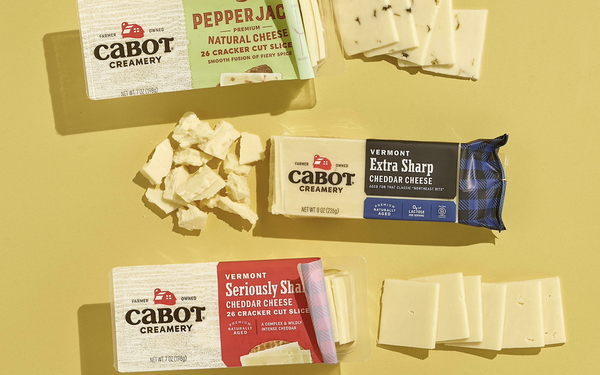
Going
beyond the century mark is a natural time for a brand to consider how to refine its identity for the future.
Vermont-based Cabot Creamery, which began as a regional dairy cooperative 1919,
recently launched a rebranding campaign centered around changes to its visual identity.
CPG Insider discussed the rebranding with Senior Vice President of Marketing Sarah Healy.
This interview has been edited slightly for clarity and length.
CPG Insider: What made it the right time for Cabot to pursue a rebranding? Were there specific
sales challenges or market trends you're seeking to address?
Sarah Healy: In 2019, Cabot celebrated its centennial, meaning our cooperative turned 100! As a beloved brand with
passionate, loyal consumers and a deep heritage, we knew that Cabot’s future could be as vibrant as its past. It was clear that the brand had tremendous potential for growth, but that would
require introducing Cabot to new markets and new consumers. We saw an opportunity for the brand to communicate more clearly, cohesively, and compellingly as we embarked on expansion.
advertisement
advertisement
CPG
Insider: What are the challenges and benefits inherent in being a legacy brand when it comes to reaching younger consumers?
Healy: I think that being a legacy brand will
be a big part of our future success. Cabot’s cooperative structure, our thoughtful business practices, and our product quality have been proven out over decades. Younger consumers, who can be
suspicious of big brands and multinationals, look at a brand like Cabot as something of an antidote.
But we needed to contemporize the brand to appeal to those consumers without fundamentally
altering the Cabot brand’s DNA. We needed to preserve Cabot’s warmth and charm in a way that wouldn’t alienate our existing consumers but would simply make the appeal of Cabot
broader. We wanted more consumers to have a seat at our table.
CPG Insider: Can you elaborate on how the new logo was designed to command a bigger shelf presence and appeal to
younger consumers?
Healy: The previous logo was charming and well-loved, but the green and red colorway and small text could make it a little recessive on shelf. So we transitioned
to a bolder red and black colorway for a faster read and more on-package punch. We also added “Creamery” to the base of the logo to ground our brand identity in who we are and what we do.
That addition, in a clean, contemporary font, is juxtaposed with the heritage Cabot logotype – which underwent some refinements, but is largely unchanged except for the color. In consumer
testing, we found that this new logo better appealed to younger consumers without alienating our existing customers, which was exactly our intent.
CPG Insider: Can you
elaborate on Cabot's sustainability measures? How does the rebrand relate to an increased focus on sustainability as an important part of Cabot's brand identity? Is this something the brand felt
consumers weren't sufficiently aware of?
Healy: Our farmers are stewards of their land, and we have farms in the cooperative that have been operating since the 1600s. That’s
remarkable, and it imbues Cabot with a deep sense of responsibility. It’s that duality between past and future that we worked to embed in our brand identity, as that is very much alive in the
cooperative. Our members are always looking for better, and more sustainable ways to farm because they absolutely understand that’s critical to their future. And they are using decades and
sometimes centuries worth of experience to help guide them.
CPG Insider: Is it more challenging for such a well-established brand to convince consumers of a commitment to
sustainability, compared to a newer brand positioning itself in such a way?
Healy: Cabot recently celebrated 10 years as a B Corporation, so we allow for our certification to
really speak to our commitment to a triple bottom line, meaning we look at our company’s financial performance, but we also look at how we performed when it comes to people and the planet. But
honestly, we prefer to present consumers with the facts around our practices and allow them to make up their own minds, which was the intent of our Purpose in Action report.